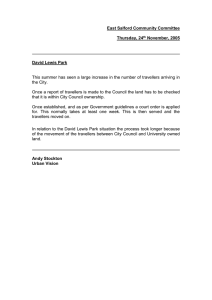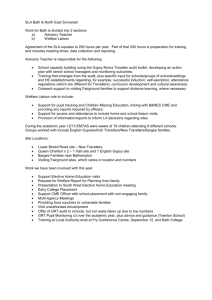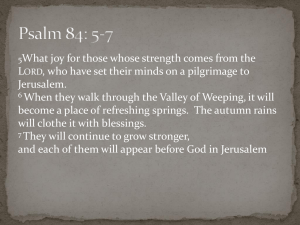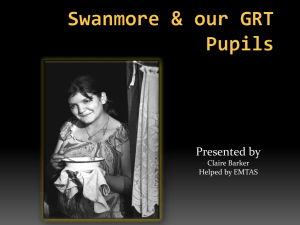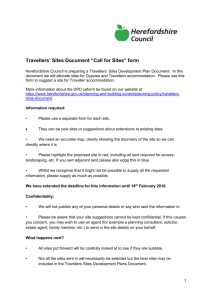The Social Affordances of Flashpacking Exploring the Mobility Nexus of Travel and Communication
advertisement
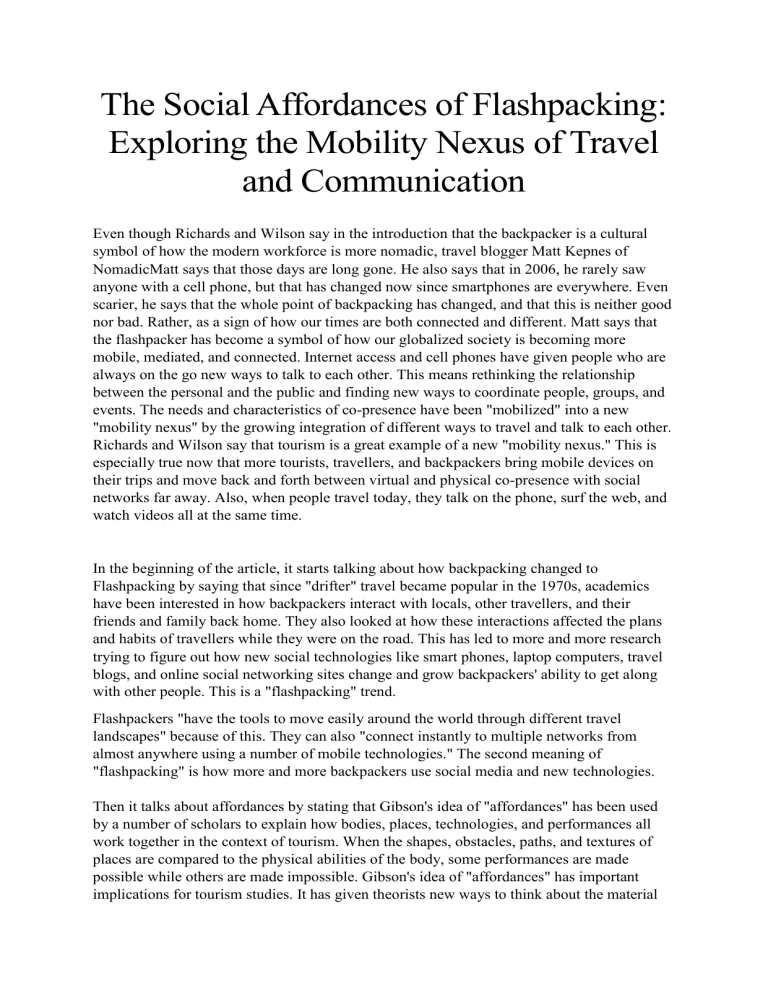
The Social Affordances of Flashpacking: Exploring the Mobility Nexus of Travel and Communication Even though Richards and Wilson say in the introduction that the backpacker is a cultural symbol of how the modern workforce is more nomadic, travel blogger Matt Kepnes of NomadicMatt says that those days are long gone. He also says that in 2006, he rarely saw anyone with a cell phone, but that has changed now since smartphones are everywhere. Even scarier, he says that the whole point of backpacking has changed, and that this is neither good nor bad. Rather, as a sign of how our times are both connected and different. Matt says that the flashpacker has become a symbol of how our globalized society is becoming more mobile, mediated, and connected. Internet access and cell phones have given people who are always on the go new ways to talk to each other. This means rethinking the relationship between the personal and the public and finding new ways to coordinate people, groups, and events. The needs and characteristics of co-presence have been "mobilized" into a new "mobility nexus" by the growing integration of different ways to travel and talk to each other. Richards and Wilson say that tourism is a great example of a new "mobility nexus." This is especially true now that more tourists, travellers, and backpackers bring mobile devices on their trips and move back and forth between virtual and physical co-presence with social networks far away. Also, when people travel today, they talk on the phone, surf the web, and watch videos all at the same time. In the beginning of the article, it starts talking about how backpacking changed to Flashpacking by saying that since "drifter" travel became popular in the 1970s, academics have been interested in how backpackers interact with locals, other travellers, and their friends and family back home. They also looked at how these interactions affected the plans and habits of travellers while they were on the road. This has led to more and more research trying to figure out how new social technologies like smart phones, laptop computers, travel blogs, and online social networking sites change and grow backpackers' ability to get along with other people. This is a "flashpacking" trend. Flashpackers "have the tools to move easily around the world through different travel landscapes" because of this. They can also "connect instantly to multiple networks from almost anywhere using a number of mobile technologies." The second meaning of "flashpacking" is how more and more backpackers use social media and new technologies. Then it talks about affordances by stating that Gibson's idea of "affordances" has been used by a number of scholars to explain how bodies, places, technologies, and performances all work together in the context of tourism. When the shapes, obstacles, paths, and textures of places are compared to the physical abilities of the body, some performances are made possible while others are made impossible. Gibson's idea of "affordances" has important implications for tourism studies. It has given theorists new ways to think about the material and multisensory parts of tourist performances. Larsen's analysis shows how digital photography technologies and social practices interact in complex ways. This suggests that we should think about new technologies not only in terms of their physical and perceived affordances, but also in terms of their social affordances. Other people who study tourism have also noticed how different places allow or prevent visitors from doing certain things. These scholars have done a good job of using the idea of "affordance" to change the way they think about tourist places and performances. Instead of being pre-made containers for tourist activities, tourist places and performances are now seen as fluid, connected, and related. Gibson means by "affordance" the ways in which the physical qualities of a certain environment make it possible or impossible for certain embodied performances to happen there. Describe how the beach, with its unique combination of wet and dry sand, stones, and sticks, as well as the family assemblages of eager youngsters and indulgent parents, makes it possible for people to undertake sandcastle construction at the beach. In the methodology Richards and Wilson talk about ethnography and say that ethnography has been a good way to study the mobility and cultures of backpackers because it focuses on long-term presence in communities of practice. This has allowed researchers to get to know travellers better. Traditional ethnography, on the other hand, requires being immersed in a place and going "into the field." This is hard to do with backpackers, who, by definition, are "an un-territorialized community characterized by impromptu social interactions." A mobile virtual ethnographic approach thinks of the field as a place where people can interact in different ways at different places. It is located in both real and virtual places, like the different places where backpackers go. This meant that we had to move with our respondents across both real and virtual spaces. This meant getting involved in the "blogosphere" and the "statusphere," which are interactive online worlds where people constantly update their status on social networking sites and travel blogs. We spent a lot of time "hanging out" online and following along as our respondents moved through these hybrid spaces, tweeted updates, posted digital photos and videos online, wrote blog posts, linked to other flashpackers' social networking profiles, mapped their location on Google Earth, commented on other travel blogs, or replied to comments on their own blogs. Also, because these mediated forms of copresence can last over time and space, they made it possible for people to stay in touch with backpackers for long periods of time. Richards and Wilson describe what they see as four key social affordances of flashpacking: Virtual mooring in the statusphere: The statusphere, which is defined as the state of publishing, reading, responding to, and sharing micro-sized updates, is dominated by social media platforms like blogs and online social networking sites like Facebook and Twitter. Second, the statusphere has changed the way people talk and interact with each other online. Peers now share and pick what to share with the stratosphere. Social networking tools like Twitter's "RT" (Twitter Re-tweet) and Facebook's "likes" and comments give people more control over how information spreads and how people connect with each other. These small actions have an effect on the whole social graph, causing a lot of movement and activity that can be tracked. This content makes a mix between backpackers' "road culture" and their "virtual culture" by bringing together real-world experiences and spaces in the statusphere. Third, the statusphere becomes a place where backpackers can connect virtually, not just as individuals but as a group. Following: In fact, "following" is now a common way to talk about how people talk to each other on social media sites. There are a number of ways in which status updates and travel blogs change the way people interact with each other. First of all, travel blogs are written in reverse chronological order, which makes them feel like serials and draws readers into the story. Following gives readers, a sense of being close to the traveller on a day-to-day basis as they learn about small things that happen along the way, like the traveller growing facial hair or getting sick. But if you want to be a part of the traveller's journey as it happens, you have to read the blog every day. Following someone on social media sites like Facebook and Twitter gives you a feeling of "ambient intimacy" by giving you access to the details of someone's everyday life, no matter how mundane they are. So, in the case of travel blogs, following is not just useful, but also has an effect. It lets the traveller's friends, family, and even strangers feel emotionally connected to them, give them a sense of control, care about them from afar, or travel with them in a way. Collaborating: The social technologies that flashpackers like give travellers new ways to connect with their friends and family back home. They also give travellers new ways to connect with other travellers on the road. In many ways, flashpacking expands the tight communication networks that have been a part of backpacker culture for a long time. This often helps travellers become part of the backpacker culture. Cohen noticed in his early study of "drifters" that travellers with more experience tell new travellers what they know. As more and more backpackers bring technology on their trips, the information that travellers share also changes. Now, travellers give each other advice not only about where to go or what to do on the trip, but also about how to be a flashpacker. In some ways, flashpacking gives female travellers, especially those who want to travel alone, new options by making them feel safe and part of a group. (dis)connecting. So far, the article talked about how social media and networking technologies let backpackers stay in touch and work together while they're on the move. However, these technologies also let backpackers disconnect in new ways. This can happen because someone doesn't want to be disconnected from their local environment, because the power goes out or because they don't have Internet access, or because someone wants to manage the constant availability of flashpacking. In the early days of flashpacking, being able to connect to the Internet from remote places was a big deal. Now, flashpackers find it more interesting when they can't connect than when they can. Flashpackers often say that they go out of their way to warn their friends, families, and especially their parents before going to "dead zones." However, sometimes travellers use these technologies to stay away from their online audience or social network. Some travellers change identifying information on their blogs or wait to post blog entries on purpose so that people who read them online don't know where they are. Many of the flashpackers who were interviewed said that they moved their close relationships to Facebook or email, where they had more control over who could see their status updates, and used Twitter or their travel blogs for public social interactions because they were easier to access. Conclusion: Flashpacking is quickly becoming the norm. When you share things on social media, the internet makes it easy for people from all over the world to find out about your travels. A lot of backpackers don't keep blogs. Instead, they just post updates and photos from time to time on Facebook. This shows that most travellers are now used to using new technologies on their trips. Logging into Facebook, sending emails home, uploading photos, or texting friends is now a normal part of a mobile lifestyle, and people do these things so that friends and family can keep up with them but also strangers. Flashpacking gives a new way to look at questions about privacy and surveillance online that keep coming up. Maybe the most interesting thing about flashpackers is how they come up with different ways to avoid their social networks. Flashpackers fight against the goal of technologically mediated togetherness by trying to avoid, control, and manage how accessible they are and to whom. Exploring the social benefits of flashpacking tells us less about the technology itself and more about what travellers want and worry about when they are mobile and connected. Whether or not travellers pack digital devices and travel as "flashpackers," the almost universal spread of smartphones, portable computers, social media and networking technologies, and other similar technologies has changed the way people travel and the world they visit. The social benefits of flashpacking that we've talked about here give us a glimpse into how backpacking is changing, but they also show how our way of being together is changing in a society that is becoming more mobile and connected.
